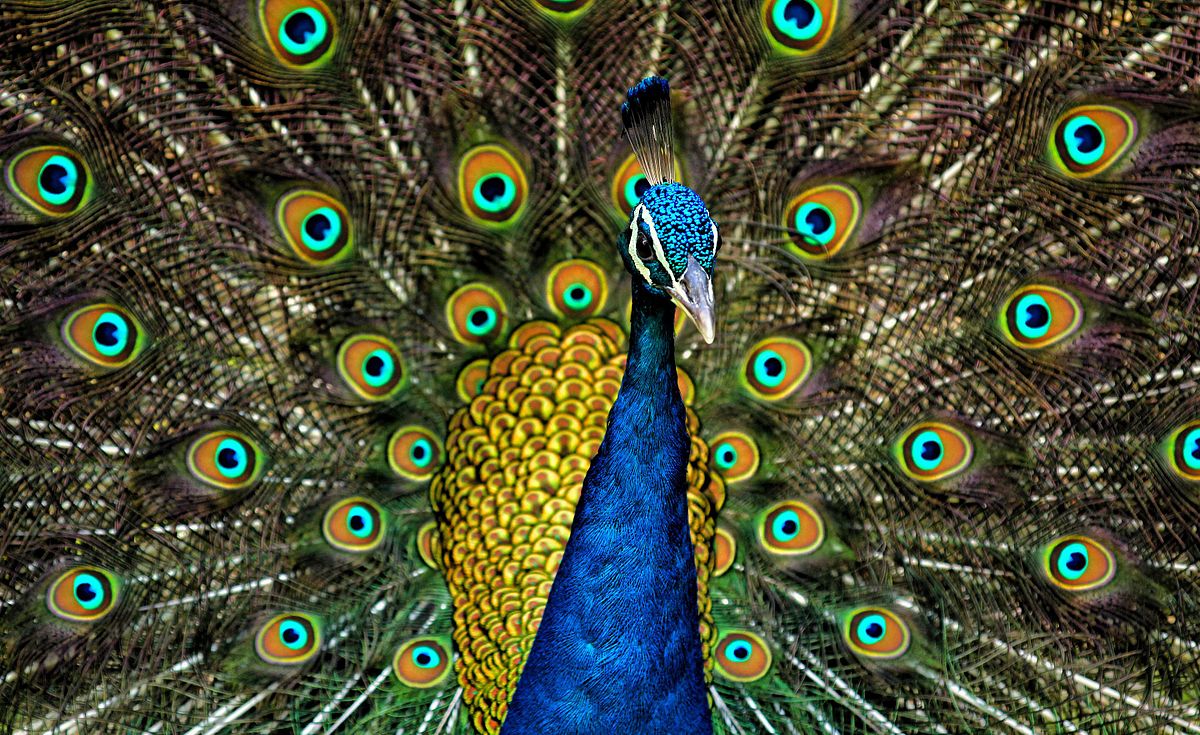Peacock, one of the most beautiful birds in the world, has a fascinating history that dates back thousands of years. Native to the Indian subcontinent, this magnificent bird is known for its vibrant tail feathers and distinctive call. In this blog post, we will explore the history, facts, size, habitat, and classification of the peacock.
The peacock, also known as the Indian peafowl, has been admired and revered by humans for centuries. In ancient times, it was considered a symbol of royalty and beauty. It has been depicted in various art forms, including paintings, sculptures, and textiles. Today, the peacock is cherished for its stunning appearance and unique qualities.
Peacocks are medium-sized birds, with males being larger than females. The male peacock, called a peacock, boasts a spectacular train of feathers that can reach up to six feet in length. These feathers, adorned with iridescent colors, are used by the male during courtship displays to attract females. The female peacock, known as a peahen, has a more modest appearance, with a brownish-grey plumage.
Peacocks are predominantly found in tropical forests and grasslands of the Indian subcontinent. They are known to roost in tall trees and feed on a variety of insects, fruits, and seeds. While they are not considered endangered, deforestation and habitat loss pose a threat to their population.
The peacock is a remarkable creature that captivates us with its vivid colors and regal presence. Its rich history, impressive size, natural habitat, and classification all contribute to its allure. Understanding the peacock’s story helps us appreciate the beauty and importance of nature’s creations like the peacock. Stay tuned for our upcoming posts where we will dive deeper into the world of Animals Name.
History of Peacock
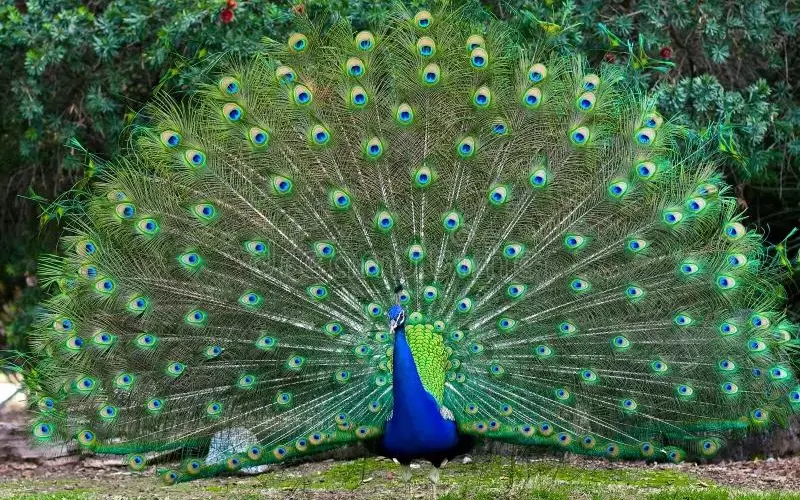
The peacock is a beautiful bird that is native to countries like India and Sri Lanka. It is known for its striking appearance, with a long, colorful tail that has unique eye-shaped spots. Peacocks are mostly found in forests and grasslands, and they are often seen perched on trees or roaming around on the ground.
The history of peacocks dates back to ancient times. They have been referenced in various ancient texts and mythologies, and they hold significant cultural and religious symbolism in many countries. In Indian mythology, the peacock is associated with the deity Lord Krishna, who is often depicted with peacock feathers adorning his head. In Greek mythology, the peacock is linked to the goddess Hera, symbolizing beauty and immortality.
Peacocks are also known for their elaborate courtship displays. During mating season, the male peacock spreads its feathers in a magnificent fan to attract a mate. The vibrant colors and patterns of the tail feathers are mesmerizing and are a sight to behold.
In recent times, peacocks have become popular symbols of beauty and elegance. They are often featured in artwork, fashion, and home decor. Many people visit zoos and parks to catch a glimpse of these magnificent birds up close.
The peacock is a majestic bird with a rich history and cultural significance. Its stunning appearance and unique behavior make it a fascinating species to learn about.
Importance of Peacock
The peacock is a majestic bird with beautiful feathers that are admired by many people. These feathers are colorful and eye-catching, making the peacock one of the most attractive birds in the world. Apart from its beauty, the peacock plays an important role in our ecosystem.
Firstly, the peacock helps to control the population of insects and pests. It feeds on small creatures like insects, worms, and snakes, making it useful for farmers and gardeners. By doing so, the peacock helps in maintaining the balance of our environment and protects our crops from being destroyed by pests. Their diet also includes vegetation, which helps to spread seeds and promote plant growth.
Secondly, the peacock is an integral part of our cultural and religious beliefs. In many cultures, the peacock is considered a symbol of beauty, grace, and immortality. It is often associated with deities and is believed to bring good luck and prosperity. The peacock feathers are used for various decorative purposes, including traditional costumes and rituals.
Lastly, the peacock is a source of wonder and inspiration for artists, photographers, and nature enthusiasts. Its vibrant plumage and extravagant courtship displays have captivated the human imagination for centuries. By observing and studying peacocks, we can learn about the diversity and wonders of the natural world.
The peacock holds great importance in our world. It helps in maintaining the ecological balance, plays a significant role in our cultural beliefs, and inspires us with its natural beauty. So let us appreciate this magnificent bird and work towards conserving its habitat for generations to come.
Amazing Facts About Peacock
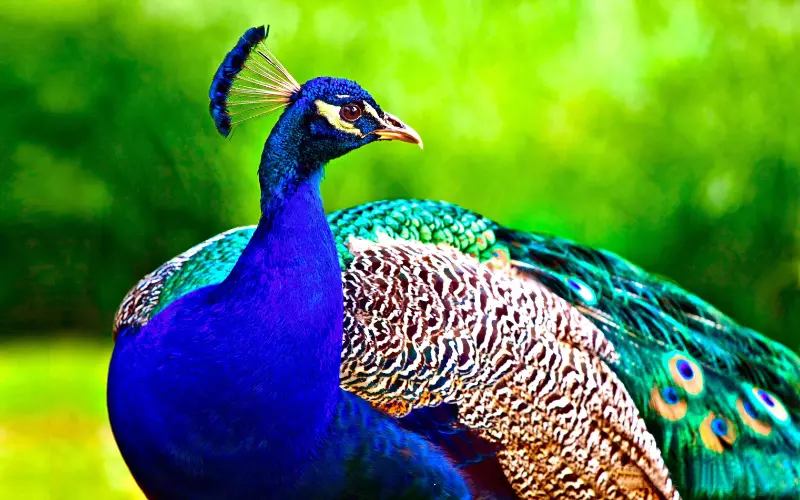
1. Peacocks are large and colorful birds known for their beautiful plumage.
2. They belong to the pheasant family and are native to South Asia, including countries like India and Sri Lanka.
3. Male peacocks, called peafowls, have long and vibrant feathers that can reach up to 6 feet in length.
4. The colorful plumage of male peacocks helps attract female peahens during mating season.
5. While male peacocks are known for their extravagant appearance, female peahens have duller feathers and are smaller in size.
6. Peacocks are omnivorous creatures, which means they eat both plants and animals.
7. Their diet typically consists of seeds, fruits, insects, small reptiles, and even small mammals.
8. Peacocks have a distinctive call, often described as a loud scream or a high-pitched cry.
9. They are capable of flying despite their large tail feathers, but they tend to prefer walking or running.
10. Peacocks are known for their territorial behavior and can become aggressive towards other males during mating season.
11. They are very social birds and often form small groups known as parties or flocks.
12. Peacocks have excellent eyesight and are capable of seeing colors that humans cannot perceive.
13. The lifespan of a peacock is about 15 years in the wild, but they can live up to 20 years in captivity.
14. These birds are considered sacred in many cultures and symbolize beauty, immortality, and spirituality.
15. Peacocks molt their feathers every year, usually after the mating season, and grow a new set of feathers to replace the old ones.
Can we keep Peacock as our Pet?
Keeping a peacock as a pet might seem like a fascinating idea, but it is not the best option. Peacocks are beautiful creatures that are known for their colorful feathers and majestic appearance. However, they are not suitable pets for several reasons.
Firstly, peacocks require a large space to roam around freely. In their natural habitat, peacocks can fly and spend their days exploring the wilderness. It would be unfair to confine them to a small backyard or a cage. They need a vast area to move around and express their natural behaviors.
Secondly, peacocks have specific nutritional needs that are challenging to meet in a domestic setting. They require a varied diet consisting of insects, fruits, seeds, and plants. Providing a proper diet for them may be difficult and expensive. Additionally, peacocks produce a significant amount of waste, which can be messy and difficult to manage indoors.
Lastly, peacocks are wild animals and not naturally inclined to bond with humans. They are known to be independent creatures, and trying to force a pet-owner relationship may lead to stress for the bird. It is crucial to respect their natural instincts and allow them to thrive in their natural habitat.
While it might be tempting to keep a peacock as a pet due to their beauty, it is important to consider their needs and natural behaviors. Peacocks require ample space, specific nutrition, and have a different temperament compared to conventional pets. Instead of trying to keep them as pets, it would be better to admire and appreciate these magnificent birds in their natural environment.
Size of Peacock
The peacock is a beautiful bird known for its vibrant colors and impressive size. It is one of the largest flying birds in the world. An adult peacock can grow up to 5 feet long, with its elegant tail feathers accounting for about 60% of its total length. The male peacock, also called a peafowl, is bigger than the female, known as a peahen.
The stunning tail feathers of a male peacock can reach a length of up to 6 feet! These feathers, adorned with eye-like spots, are used to attract a mate during courtship displays. They can be raised and spread out into a magnificent fan shape, creating a breathtaking sight. It is worth noting that the feathers of a peacock are not only long but also quite heavy, sometimes weighing more than the bird itself.
Apart from their long tail feathers, peacocks have a stocky and muscular body. They have strong legs which allow them to run at impressive speeds, reaching up to 10 miles per hour. Their wingspan, on the other hand, can measure about 5 feet, enabling them to glide gracefully through the air. Despite their large size, peacocks are excellent flyers, even capable of reaching treetops or other elevated places.
To sum up, peacocks are magnificent creatures known for their impressive size. With their long and colorful tail feathers, they showcase a stunning display when trying to attract a mate. They are one of the largest flying birds, boasting a body length of around 5 feet and a wingspan of about 5 feet as well. Overall, peacocks are majestic birds that captivate our attention with their regal beauty.
Habitat of Peacock
A peacock’s natural habitat is usually found in the wild where they can roam freely. They are commonly found in forest areas near water sources, such as rivers or lakes. These beautiful birds prefer living in warm climates and can be found in countries like India, Sri Lanka, and Myanmar.
Peacocks enjoy living in places that have dense vegetation, like tropical rainforests. The trees and plants provide them with shelter and protection from predators. The peacock’s vibrant feathers are also helpful in this habitat, as they easily blend with the vibrant colors of the forest, allowing them to hide from potential danger.
Additionally, peacocks love to be around water. They are often seen near rivers or lakes, as they frequently drink water and bathe to keep their feathers clean and healthy. Water bodies also attract small insects and other animals that make up a large portion of the peacock’s diet. This habitat is advantageous for the peacock, as it brings them both food sources and a safe place to live and thrive.
Peacocks are commonly found in warm climates with dense vegetation, such as tropical rainforests. They prefer to live near water sources, like rivers or lakes, where they can find food and bathe. These habitats provide the peacock with a safe environment, allowing them to display their magnificent feathers and live a content, natural life.
Classification of Peacock
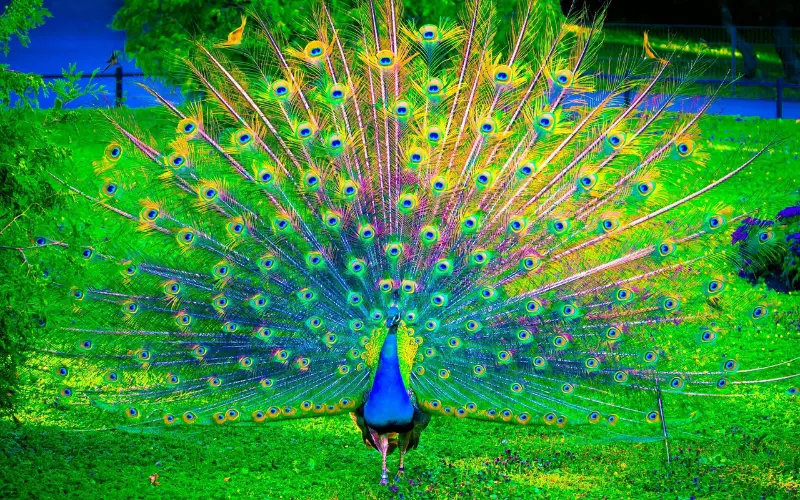
The peacock, also known as the Indian peafowl, belongs to the animal kingdom’s class Aves. Aves is the class of birds that have feathers, beaks, lay eggs, and have wings for flying. Peacocks are further classified into the family Phasianidae, which includes other types of birds such as pheasants, quails, and partridges.
Within the family Phasianidae, the peacock falls into the genus Pavo. The genus is a category used in the classification system to group closely related species. There are three species of peacocks in the genus Pavo: the Indian peafowl (Pavo cristatus), the Green peafowl (Pavo muticus), and the Congo peafowl (Pavo cristatus).
The Indian peafowl, also known as the common peafowl, is the most well-known and widely recognized species of peacock. The male Indian peafowl has a beautiful long train of feathers that can be opened up into a fan-like display. This train, with its vibrant colors and striking patterns, is used by the males to attract females during their mating rituals.
The peacock belongs to the class Aves, which includes all birds. It is classified within the family Phasianidae along with other bird species like pheasants and partridges. Within the Phasianidae family, the peacock falls into the genus Pavo, which includes three different species, with the Indian peafowl being the most common and recognizable one.
Different Types of Peacock
1. Indian Peacock: The Indian peacock, also known as the Indian peafowl, is one of the most well-known and iconic types of peacocks. It is famous for its vibrant blue and green feathers and can be found in various regions across India.
2. Green Peacock: The green peacock is found in parts of Southeast Asia, including Indonesia, Myanmar, and Thailand. It is distinguished by its magnificent feathers that have both green and blue hues, creating a stunning display.
3. Congo Peacock: The Congo peacock is native to the Democratic Republic of Congo in Africa. It has striking blue plumage and a unique hairstyle of feathers on the top of its head. The Congo peacock is relatively smaller compared to other types.
4. White Peacock: The white peacock is a stunning variant of the Indian peacock, characterized by its completely white or cream-colored feathers. Although lacking the bright blue and green colors, its unique appearance makes it an elegant and sought-after breed.
5. Black-shouldered Peacock: Commonly found in Southeast Asia, the black-shouldered peacock is named due to its black feathers on the wings and shoulders. The rest of its plumage consists of a mix of blue, green, and brown shades, creating a beautiful contrast.
6. Java Peafowl: The Java peafowl is native to the Indonesian island of Java. It closely resembles the Indian peacock in appearance, with a combination of blue and green feathers. However, it has shorter and more rounded tail feathers.
7. Burmese Peacock: As the name suggests, the Burmese peacock comes from Myanmar (Burma). This type displays a mix of blue, green, and bronze colors in its plumage. Its tail is shorter than that of the Indian peacock, but still magnificent.
8. Bronze Peacock: The bronze peacock, found in Indonesia and Malaysia, is renowned for its striking bronze-colored feathers. Though less colorful compared to other peacock breeds, its unique metallic hue gives it a regal appearance.
9. Spalding Peacock: The Spalding peacock is not a natural species but a hybrid. Its vibrant feathers combine the colors of the Indian, green, and white peacocks, resulting in a mesmerizing display of blue, green, and white hues.
10. Pied Peacock: The pied peacock is another hybrid variety that results from crossbreeding different peacock types. It features a distinctive pattern with patches of white feathers interspersed among its usual blue, green, or bronze plumage, making it truly eye-catching.
Geographical Presence of Peacock
The Peacock, also known as the Indian Peafowl, is commonly found in Asia. Its natural habitat is spread across several countries in the region, including India, Sri Lanka, Bangladesh, and Pakistan. These beautiful birds are often seen in forests, open grasslands, and even near human settlements. Their vibrant feathers, especially the long and colorful tail feathers, make them a spectacle to behold.
However, peacocks are not found in other parts of the world. They are not native to Europe, Africa, or the Americas. Instead, they are limited to the Asian continent. This means that if you live in these other regions, you may not have the chance to see these magnificent birds in their natural habitat.
One of the reasons peacocks are not found outside of Asia is because they are highly adapted to the specific environmental conditions found in this region. They require certain plant species, food sources, and climate conditions to survive and thrive. Hence, they are restricted to the regions where these conditions are met.
Peacocks are mainly found in Asia, particularly in countries such as India, Sri Lanka, Bangladesh, and Pakistan. These beautiful birds are not found in other parts of the world, including Europe, Africa, and the Americas, as they are specifically suited to the environmental conditions of the Asian continent.
Diet of Peacock’s
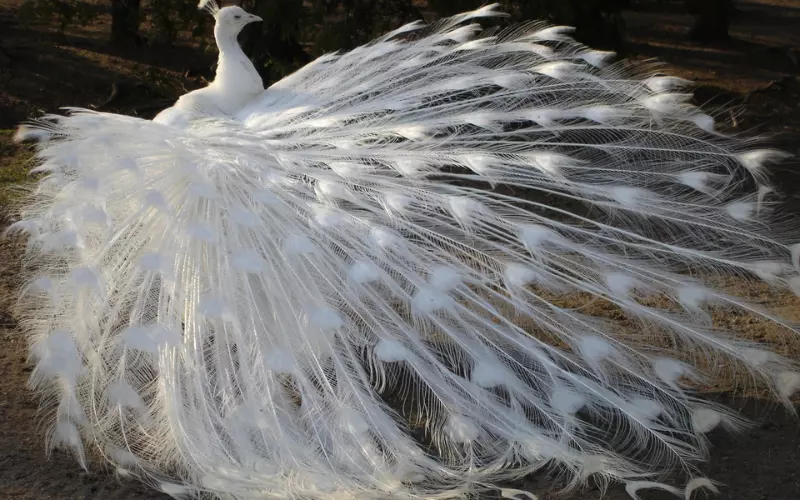
Peacocks have a special diet that helps them stay strong and healthy. Their diet mainly consists of plants and small animals. Peacocks like to eat a variety of fruits, berries, and seeds. They also enjoy munching on insects, small reptiles, and even small mammals like mice. By eating a balanced diet, peacocks are able to get all the nutrients they need to survive.
Fruits and berries are an important part of a peacock’s diet. These provide important vitamins and minerals that help the peacock maintain good health. Seeds are also a great source of energy for these beautiful birds. They especially love to eat the seeds of flowers and grasses.
In addition to plants, peacocks also eat small animals. Insects like beetles, ants, and termites are a tasty treat for them. They have a sharp beak that allows them to catch and eat these tiny creatures. Sometimes, peacocks also catch small reptiles like lizards and snakes. They are also known to eat small mammals such as mice and even baby rabbits.
Peacocks have a diverse diet that includes fruits, berries, seeds, insects, reptiles, and small mammals. This diet provides them with the essential nutrients and energy they need to survive in the wild. Peacocks are truly fascinating creatures, not just because of their beautiful feathers but also because of their interesting eating habits.
Locomotion of Peacock’s
Peacocks move about in a very interesting way called locomotion. They walk gracefully on their long legs, but their main attraction is their ability to spread their beautiful feathers into a big, vibrant fan. This display is called a “train” and it helps them catch the eyes of others. When a peacock is walking or strutting, it swings its elegant train from side to side, creating a stunning spectacle.
In addition to walking, peacocks also have the ability to fly. Despite the fact that they have large, heavy feathers, they can glide through the air for short distances. When they take off, their wings make a sound that resembles the noise of a helicopter. Even though they are not the best at flying long distances, they can still manage to escape danger and find food by using their wings. Peacocks are truly amazing creatures with their unique locomotion and colorful feather display.
Social and Sexual Behaviour of Peacock’s
Peacocks are colorful and beautiful birds known for their extravagant feathers and elegant dances. These impressive features play an essential role in their social behavior. Peacocks live in small groups called flocks, which consist of one male, called a peacock, and several females, called peahens. The males are the ones with the vibrant feathers, which they display to attract the females during courtship.
During courtship, the male peacock spreads its feathers wide open, forming an impressive fan shape. He then dances and shakes his feathers to catch the attention of the peahens. The brighter and more colorful the feathers, the more likely the peahen will be attracted to him. The peacock’s courtship display is a way of showing off his good health and fitness to the females.
The peahens observe the male’s courtship display and choose the peacock with the most impressive feathers as their mate. Once the peahen has selected a mate, they engage in mating behavior. The male peacock spreads his magnificent feathers again while the female remains close by. After mating, the female is solely responsible for building a nest and caring for the eggs until they hatch.
The social and sexual behavior of peacocks revolves around their colorful feathers and elaborate courtship displays. The male peacock showcases its beautiful plumage to attract the attention of the females, who then choose their mate based on the peacock’s display. This behavior ensures the survival of the peacock species by allowing the healthiest and most attractive males to pass on their genes.
Reproduction and Lifecycle of Peacock’s
Peacocks have a unique way of reproducing and going through life. They have a special life cycle, which is fascinating to learn about. Let’s explore how these beautiful birds reproduce and grow.
First, let’s talk about peacock eggs. The female peacock, also known as a peahen, lays about 3 to 8 eggs in a clutch. She usually chooses a safe and hidden spot on the ground to lay her eggs. After laying the eggs, the peahen takes great care to protect them from predators. She sits on the eggs for about a month, keeping them warm until they hatch.
After the eggs hatch, cute baby peacocks, called peachicks, come out. They have brown feathers with some stripes. The peachicks stick close to their mother for safety and warmth. As they grow older, their feathers start changing color, showing beautiful shades of blue, green, and gold. It takes about 3 years for a peacock to reach its full colorful plumage.
Once the peachicks grow up and become adults, they are ready to find a mate and reproduce. The male peacocks, known as peafowls, perform an elaborate courtship display to attract a female. They spread their long, colorful tail feathers into a dazzling fan shape and make a loud call to impress the peahens. The female peafowls choose their mates based on the beauty and size of the male’s tail feathers.
In this way, peacocks go through their life cycle. They start as tiny eggs, grow into cute peachicks, and eventually turn into majestic adult peafowls. It’s truly amazing to learn about their reproduction and admire their stunning beauty!
Threats to Peacock’s
Peacocks are beautiful birds known for their colorful feathers and elegant appearance. However, they face several threats that put their survival at risk. One major threat to peacocks is habitat loss. As human populations grow, forests and grasslands where peacocks live are often cleared for agriculture, industries, and urban development. This reduces the available space for peacocks to find food, nest, and raise their young.
Another threat to peacocks is poaching. Some people illegally hunt these birds for their feathers, which are highly valued for decorative purposes. Peacock feathers are used in fashion accessories and crafts, leading to a high demand in the market. Unfortunately, this illegal trade puts immense pressure on peacock populations, as many birds are killed to fulfill this demand.
Additionally, pollution poses a considerable threat to peacocks. Pesticides and other chemicals used in farming and industries can contaminate the water, soil, and air in peacock habitats. This pollution can directly harm the birds or impact their food sources, leading to a decline in their population. The pollution also affects the quality of their habitats, making it harder for peacocks to find suitable places to rest, nest, and raise their chicks.
To protect peacocks, it is crucial to conserve their natural habitats by preventing deforestation and promoting sustainable development. Governments and local communities should enforce laws against poaching and increase efforts to educate people about the importance of conserving these birds. Additionally, minimizing pollution through the use of eco-friendly practices will help preserve the health of peacock populations and their habitats. By taking these steps, we can help ensure the continued existence of these magnificent birds for future generations to admire.
Conclusion
The peacock is a fascinating creature with a rich history and impressive facts. These animals are known for their beautiful feathers and their ability to attract attention. Peacocks have been a part of human culture for thousands of years, with many ancient civilizations considering them symbols of beauty and royalty. Today, they can be found in various parts of the world, particularly in India and Sri Lanka.
These majestic birds are part of the pheasant family and are among the largest flying birds. Male peacocks, also known as peafowls, are the ones with the colorful feathers, while the females, called peahens, have more subdued appearances. The vibrant plumage of the males is used to attract mates during courtship displays. Despite their large size, peacocks are agile flyers and can travel significant distances.
Peacocks are highly adaptable and can live in a variety of habitats, including forests, grasslands, and even urban areas. They are omnivores, meaning they eat both plants and small creatures like insects and reptiles. While humans are fascinated by their beauty, peacocks face threats from habitat loss and hunting. Conservation efforts are essential to ensure the survival of these magnificent animals for future generations to appreciate and learn from their unique characteristics.
FAQ’s
What type of animal is a peacock?
A peacock is a large bird belonging to the pheasant family.
Where do peacocks originate from?
Peacocks are native to South Asia but have been introduced to other parts of the world as well.
What are some distinct physical features of peacocks?
Peacocks are known for their vibrant plumage, especially the long, colorful feathers on their tail, known as a train.
Do both male and female peacocks have beautiful feathers?
No, only male peacocks have the elaborate and eye-catching plumage. Female peacocks, known as peahens, have a more simple appearance.
What purpose do peacock feathers serve?
Peacock feathers are primarily used for courtship displays to attract mates. They also help balance the bird while perched on trees.
Can peacocks fly?
Yes, despite their large size, peacocks are capable of flying, but they prefer to spend most of their time on the ground.
What do peacocks eat?
Peacocks are omnivorous, meaning they eat both plants and small animals. Their diet includes fruits, seeds, insects, and even small reptiles.
How long do peacocks live?
In the wild, peacocks generally live for about 15 to 20 years, while in captivity, they can live up to 25 years.
Are peacocks social animals?
Peacocks are generally social animals and can be found in small groups called parties. However, during the breeding season, males establish territories and become more solitary.
Can peacocks make any sounds?
Yes, peacocks have a unique call, which includes a loud, high-pitched scream and a series of rattling sounds.
Are peacocks endangered?
No, peacocks are not considered endangered. Their populations are stable in their native habitats and can also be found in zoos and sanctuaries worldwide.
Do peacocks make good pets?
While peacocks may appear majestic, they are not recommended as pets for most people. They require specific care and large spaces to roam freely.
Are peacocks territorial?
Yes, during the mating season, male peacocks become territorial and defend their chosen area from other males.
Can peacocks swim?
Yes, peacocks are skilled swimmers and enjoy bathing in shallow water. However, they do not fully submerge themselves.
Are peacocks important in mythology and symbolism?
Yes, peacocks are revered in many cultures and symbolize beauty, royalty, and immortality. They often appear in mythology, art, and religious iconography.

Hey there, I’m Kristen Haudenschild! I’m like a superhero for animals and people.
I work as a Dependable Hard Working Supervisor, which means I help both people and animals grow and learn. I did my school at OdySea Aquarium and Georgia Southern University in Tempe, Arizona. That’s where I learned all about animals, and guess what? I’m fascinated by them!
I even write cool articles about animals. My job history includes being an Animal Trainer and a Marine Mammal Trainer II at OdySea Aquarium. I’ve also been a Senior Animal Care Specialist and an Animal Care Specialist 2.
I love exploring animals and am always ready to help others learn more about them. So, if you ever need info about animals, give me a shout!

